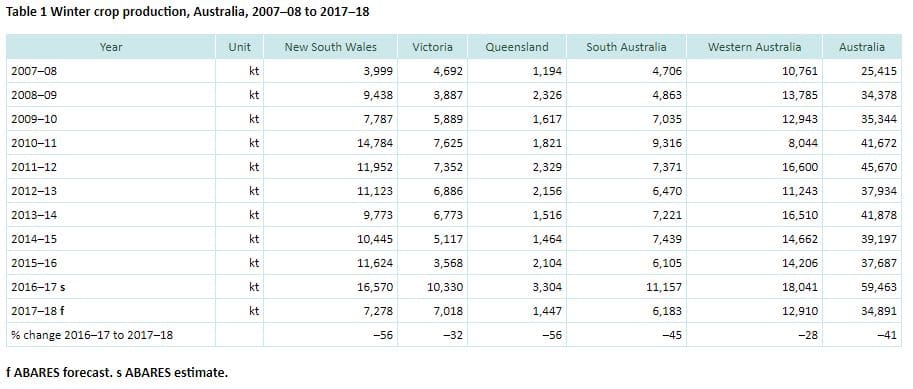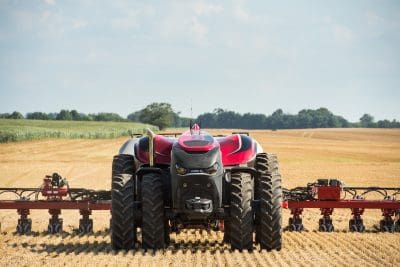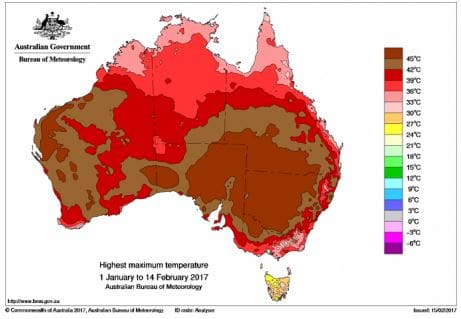IT was always going to be a tough ask for 2017 to match the extraordinary cropping year of 2016 when Australia produced a record winter crop of 59.1 million tonnes (Mt).
Not surprisingly, 2017 returned to a more ‘normal’ farming season with a wide range of conditions across the nation that produced a mix of cropping outcomes.
As the last of the 2017 crops are harvested, ABARES estimates this season’s winter crop will reach 34.9Mt, slightly below the 10-year average.
Grain Central takes a look back over the stories that led the news in the cropping world in 2017:
Summer crop
2017 started with a brutal summer that knocked the stuffing out of crops in the northern farming zone.
Grain Central reported on the record temperatures in many areas that sapped soil moisture levels and put the heat on sorghum, sunflower, mungbean and cotton crops.
- Jan 11 https://www.graincentral.com/news/summer-crops-sizzle-as-heatwave-hits-eastern-australia/
- Feb 22 https://www.graincentral.com/cropping/scorching-summer-season-stresses-nsw-sorghum/
- Feb 23 https://www.graincentral.com/weather/summer-scorcher-sends-records-tumbling-in-the-south-east/
- Feb 28 https://www.graincentral.com/cropping/southern-queensland-growers-glad-to-see-back-of-tough-summer/
Winter crop
Winter crop production for 2017 was a mixed bag with outcomes varying markedly across the nation. Harsh, dry conditions took their toll on crops in Western Australia, north west NSW and southern Queensland. Late rains saw an 11th-hour revival of winter crop prospects in WA.
In south eastern Australia, mice played havoc with crops early in the season and frosts later whacked crops in Victoria and NSW, but overall South Australia, Victoria and southern NSW emerged the winter crop winners this year.
- May 8 https://www.graincentral.com/news/mice-chew-into-crop-seeding-programs-in-southern-australia/
- Aug 22 https://www.graincentral.com/uncategorized/frost-adds-insult-to-injury-for-thirsty-winter-crops/
- Sept 12 https://www.graincentral.com/news/forecast-decrease-for-winter-crop-production-abares/
- Dec 12 https://www.graincentral.com/news/winter-crop-down-summer-plantings-up-abares/
- Dec 18 https://www.graincentral.com/cropping/grains/cbh-lifts-wa-harvest-estimate-as-receivals-hit-11-2mt/

Table: Australian winter crop production 2007/08-2017/18. (Source: ABARES) (Click on table to enlarge)
Chickpeas
Uncertainty haunted chickpeas as the year began. Australia had grown a big crop in 2016, but just how big wasn’t known and it was uncertain when the demand into India’s perilously empty storages would abate.
Growers went big again with chickpea plantings in 2017 because, at the margin, the price signals on cereals were relatively unattractive.
Chickpea prices fell away mid-year, though at A$700/tonne to $900/t still remained a handy income earner. As the 2017 growing season unfolded, dry weather continued, cutting yield for many southern Queensland and northern NSW growers.
- Jan 31 https://www.graincentral.com/markets/will-india-will-be-back-for-more-chickpeas-once-their-harvest-is-complete/
- Feb 3 https://www.graincentral.com/cropping/pulses/cargoes-and-containers-share-record-chickpea-export-task/
- July 21 https://www.graincentral.com/cropping/pulses/pulse-rate-rises-another-big-year-for-chickpeas/
- Nov 10 https://www.graincentral.com/uncategorized/hopes-for-one-million-tonne-chickpea-crop-hinge-on-nsw-slopes/
- Dec 8 https://www.graincentral.com/cropping/chickpeas-struggle-to-fill-bins-in-tough-year/
- Dec 12 https://www.graincentral.com/markets/uncertainty-is-a-market-killerpulses-hurting/
Markets and trade
The 2017 export trade of Australian cereals, oilseeds and pulses hit the ground running after a big production year in 2016.
- Nov 25 2016 https://www.graincentral.com/cropping/record-yields-at-walgett-fuel-buoyant-national-crop-outlook/
- Mar 9 https://www.graincentral.com/cropping/grain-production-to-ease-back-after-record-winter-crop-abares/
Canola shipments maintained around 0.5Mt per month for seven months. EU biofuels manufacturers purchased around $1.8 billion worth of Australian canola, and there was significant demand from south Asia.
- Mar 6 https://www.graincentral.com/markets/australian-canola-exports-setting-record-pace/
- Dec 18 https://www.graincentral.com/markets/australian-canola-first-to-gain-renewed-eu-biofuels-access/
Barley exports began slowly into a world market which viewed Australian barley as too expensive, although world barley prices strengthened enough in late summer to trigger export trade of over 1Mt each month from January-March. Australian barley shipments to China were strong, as they were to about 10 other long-term importing countries in the Middle East and elsewhere in Asia.
- Mar 21 https://www.graincentral.com/markets/saudi-confirms-purchase-of-25-cargoes-of-feed-barley/
- Mar 29 https://www.graincentral.com/markets/australia-passes-halfway-mark-on-heady-wheat-barley-canola-export-program/
- Apr 13 https://www.graincentral.com/cropping/australia-tops-world-barley-exports/
Wheat export shipments began modestly, but accelerated only when Northern Hemisphere crops in their springtime began to be threatened by drought and frost; prices at the same time striding upwards.
Enter Russia with another near record wheat crop of 93Mt, presenting another massive export task to it and other former Soviet Union (FSU) states.
Indonesia remained Australia’s biggest volume wheat market. India emerged as a welcome trading opportunity for Australian wheat.
- Mar 23 https://www.graincentral.com/cropping/grains/harvest-pressure-looming-tariff-fail-to-shake-indias-interest-in-australian-wheat/
- Mar 10 https://www.graincentral.com/trade/aegic-technical-workshops-a-success-with-millers-in-indonesia-philippines/
- Jul 4 https://www.graincentral.com/markets/grain-prices-continue-rise-ahead-of-us-holiday/
- Nov 2 https://www.graincentral.com/markets/russian-wheat-crop-will-be-a-big-one/
Technology revolution
The technology and precision agriculture revolution continued apace in 2017. From autonomous tractors and robotic weed killers to eye-in-the-sky drones and sophisticated sensing systems, the technological advances just kept coming.
- June 8 https://www.graincentral.com/machinery/the-future-is-here-autonomous-tractor-and-spraying-combo/
- July 26 https://www.graincentral.com/machinery/clearing-the-roadblocks-to-autonomous-tractors/
- Sept 12 https://www.graincentral.com/machinery/step-aside-humans-robotic-machines-farm-a-complete-crop-in-uk-trial/
- Nov 10 https://www.graincentral.com/machinery/swarmfarm-teams-with-bosch-to-secure-future-for-farming-robots/
 Research breakthroughs
Research breakthroughs
Australian researchers were once again at the forefront of game-changing discoveries that will advance the lot of crop producers. Breakthroughs in genetic and breeding techniques have provided scientists with the tools to develop better crop varieties and farming techniques.
- Jan 24 https://www.graincentral.com/cropping/breakthrough-in-breeding-drought-tolerant-wheat/
- Nov 23 https://www.graincentral.com/cropping/panel-puts-gene-editing-under-the-microscope/
- Nov 30 https://www.graincentral.com/cropping/new-wheat-for-australias-tropical-north/
- Dec 11 https://www.graincentral.com/cropping/wild-relatives-break-open-door-to-ascochyta-resistant-chickpeas/
Glyphosate
Calls in Europe for a ban on the herbicide, glyphosate, had Australian farmers wondering what the implications would be for Australia, particularly for the no-till system of farming that is so dependent on the herbicide.
After much procrastination, the European Commission extended the licence for glyphosate for another five years.
- Oct 30 https://www.graincentral.com/cropping/europe-equivocates-over-glyphosates-future/
- Nov 3 https://www.graincentral.com/cropping/australia-fears-fallout-if-europe-bans-glyphosate/
- Nov 28 https://www.graincentral.com/news/europe-renews-glyphosate-licence-for-five-years/
- Nov 29 https://www.graincentral.com/cropping/eu-re-approval-of-glyphosate-dodges-farming-economic-woes-for-now/
…………………….
For other stories from the Grain Central archive, go to the keyword ‘Search’ box in the top right-hand corner of the Grain Central website, www.graincentral.com
Grain Central: Get our free daily cropping news straight to your inbox – Click here


HAVE YOUR SAY